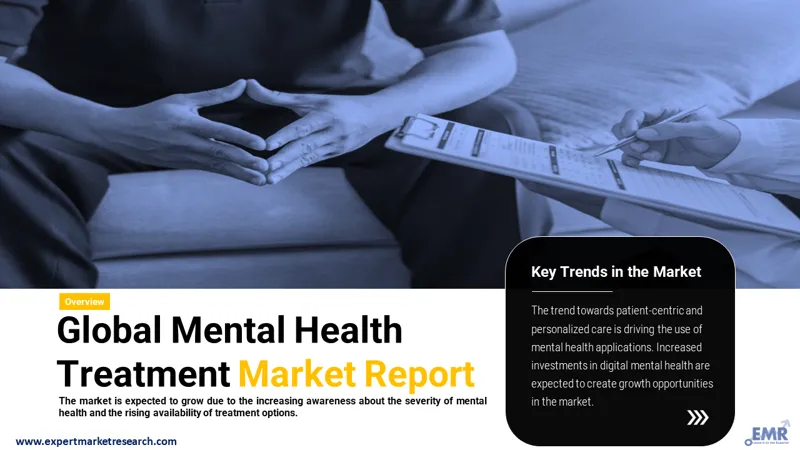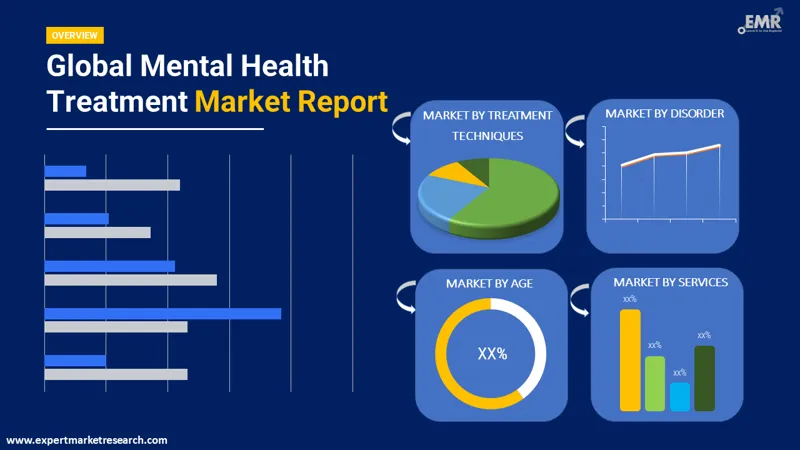
Consumer Insights
Uncover trends and behaviors shaping consumer choices today
Procurement Insights
Optimize your sourcing strategy with key market data
Industry Stats
Stay ahead with the latest trends and market analysis.
The global mental health treatment market reached about USD 437.41 Billion in 2025 and is expected to grow at a CAGR of 4.90% during the forecast period of 2026-2035. With the growing incidences of mental disorders, the market is expected to reach about USD 705.74 Billion by 2035. The growth driving factors include increased mental health awareness and high telemedicine adoption.
Base Year
Historical Period
Forecast Period
Compound Annual Growth Rate
4.9%
Value in USD Billion
2026-2035
*this image is indicative*
Mental health comprises of emotional, psychological, and social well-being. It has an impact on how one thinks, feels, and acts. It also influences how one deals with stress, interacts with others, and makes decisions. Mental health is essential throughout life, from childhood and adolescence to adulthood.
If a person has mental health issues, their thinking, mood, and behaviour may be affected throughout life. There are many factors that lead to mental health issues. Genes and brain biochemistry are examples of biological influences, whereas trauma and abuse are examples of life experiences.

Read more about this report - REQUEST FREE SAMPLE COPY IN PDF
There is no physical test or scan that can consistently determine whether a person has developed a mental disorder. People should, however, be on the lookout for the following symptoms of a mental health disorder, some of which are as follows:
There are numerous approaches to deal with mental health issues. Treatment is extremely personalised, and what works for one person may not work for another. Some techniques or treatments are more effective when used in conjunction with others. A person suffering from a persistent mental disease may make varied decisions throughout the life.
A few treatment options are psychotherapy, medication, and self-help, among others.

Read more about this report - REQUEST FREE SAMPLE COPY IN PDF
According to the global mental health treatment market research report, the market can be categorised into the following segments:
Market Breakup by Disorder
Market Breakup by Services
Market Breakup by Treatment Techniques
Market Breakup by Age
Market Breakup by Region
In 2019, 1 in every 8 individuals or 970 million people worldwide, suffered from a mental disorder, with anxiety and depression being the most frequent. Because of the COVID-19 pandemic, the number of people living with anxiety and depression increased considerably in 2020. Initial estimates reveal a 26% and 28% increase in anxiety and severe depressive disorders, respectively, in just 1 year. While there are excellent prevention and treatment alternatives, most persons with mental problems do not have access to them. Many people face stigma, discrimination, and infringement of their human rights.
Several governments are increasing their investments in telecommunications and digital technologies, as well as hiring more mental health specialists. Concurrently, mental health awareness programmes are expanding dramatically, resulting in positive market trends. Furthermore, the market is predicted to develop as healthcare infrastructure improves, as occurrences of depression cause disability increase, as the geriatric population grows.
Globally, increasing digitalisation and smartphone and internet adoption are predicted to expand the use of mental health apps. Furthermore, trends shifting from traditional methods of care toward patient-centric and personalised care are encouraging the use of mental health applications. As a result, rising investments in digital mental health are expected to create lucrative prospects for market expansion.
The report gives an in-depth analysis of the key players involved in the global mental health treatment market, sponsors manufacturing the therapies, and putting them through trials to get FDA approvals. The companies included in the market are as follows:




*While we strive to always give you current and accurate information, the numbers depicted on the website are indicative and may differ from the actual numbers in the main report. At Expert Market Research, we aim to bring you the latest insights and trends in the market. Using our analyses and forecasts, stakeholders can understand the market dynamics, navigate challenges, and capitalize on opportunities to make data-driven strategic decisions.*
Get in touch with us for a customized solution tailored to your unique requirements and save upto 35%!
The market size was valued at nearly USD 437.41 Billion in 2025.
The market is expected to grow at a CAGR of 4.90% during the forecast period of 2026-2035.
The market is expected to reach about USD 705.74 Billion by 2035.
The increased awareness about the severity of mental health and the rising availability of treatment will propel the market growth.
The regions included in this market are North America, Latin America, Asia Pacific, Europe, and Latin America. North America accounts for the largest share of the market owing to the easy availability of treatment and increased awareness of the mental health.
Mental health disorders are usually caused by stress, physical and mental trauma, social stigma, and bereavement, among others.
Mental tiredness can occur when your brain is overstimulated or is required to maintain an excessive level of activity without rest.
The key companies in the global market include Acadia Healthcare, Sevita (The Mentor Network), Universal Health Services, Inc., Behavioral Health Network, Inc., CareTech Holdings plc, Strategic Behavioral Health LLC, Ascension Seton, Takeda Pharmaceutical Company Limited, Johnson & Johnson, Inc., and Teijin Limited.
Explore our key highlights of the report and gain a concise overview of key findings, trends, and actionable insights that will empower your strategic decisions.
| REPORT FEATURES | DETAILS |
| Base Year | 2025 |
| Historical Period | 2019-2025 |
| Forecast Period | 2026-2035 |
| Scope of the Report |
Historical and Forecast Trends, Industry Drivers and Constraints, Historical and Forecast Market Analysis by Segment:
|
| Breakup by Disorder |
|
| Breakup by Services |
|
| Breakup by Treatment Techniques |
|
| Breakup by Age |
|
| Breakup by Region |
|
| Market Dynamics |
|
| Supplier Landscape |
|
| Companies Covered |
|
Datasheet
One User
USD 3,299
USD 2,969
tax inclusive*
Single User License
One User
USD 5,499
USD 4,949
tax inclusive*
Five User License
Five User
USD 6,999
USD 5,949
tax inclusive*
Corporate License
Unlimited Users
USD 8,199
USD 6,969
tax inclusive*
*Please note that the prices mentioned below are starting prices for each bundle type. Kindly contact our team for further details.*
Flash Bundle
Small Business Bundle
Growth Bundle
Enterprise Bundle
*Please note that the prices mentioned below are starting prices for each bundle type. Kindly contact our team for further details.*
Flash Bundle
Number of Reports: 3
20%
tax inclusive*
Small Business Bundle
Number of Reports: 5
25%
tax inclusive*
Growth Bundle
Number of Reports: 8
30%
tax inclusive*
Enterprise Bundle
Number of Reports: 10
35%
tax inclusive*
How To Order

Select License Type
Choose the right license for your needs and access rights.

Click on ‘Buy Now’
Add the report to your cart with one click and proceed to register.

Select Mode of Payment
Choose a payment option for a secure checkout. You will be redirected accordingly.
Gain insights to stay ahead and seize opportunities.

Get insights & trends for a competitive edge.

Track prices with detailed trend reports.

Analyse trade data for supply chain insights.

Leverage cost reports for smart savings

Enhance supply chain with partnerships.

Connect For More Information
Our expert team of analysts will offer full support and resolve any queries regarding the report, before and after the purchase.
Our expert team of analysts will offer full support and resolve any queries regarding the report, before and after the purchase.
We employ meticulous research methods, blending advanced analytics and expert insights to deliver accurate, actionable industry intelligence, staying ahead of competitors.
Our skilled analysts offer unparalleled competitive advantage with detailed insights on current and emerging markets, ensuring your strategic edge.
We offer an in-depth yet simplified presentation of industry insights and analysis to meet your specific requirements effectively.
Share